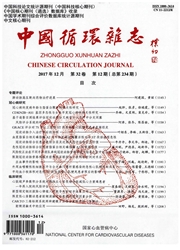

 中文摘要:
中文摘要:
目的:探讨北京市石景山区人群血浆抵抗素浓度变化与同期体重变化的关系。方法:选取我们2005年和2010年两次在北京市石景山区调查的同一人群,心血管病危险因素资料完整的研究对象943例,其中男316例,女627例,男性平均年龄为(58.2±8.5)岁,女性平均年龄为(59.3±7.5)岁。按照两次调查测定血浆抵抗素浓度变化的4分位数将943例研究对象分为:≤-0.66 mmol/L组(n=239)、-0.67~0.25 mmol/L组(n=233)、0.26~1.24 mmol/L组(n=235)和≥1.25 mmol/L组(n=236)。运用Pearson相关及多元线性回归等统计学方法,分析血浆抵抗素浓度变化与同期的体重变化指标之间的关系。结果:单因素相关分析显示,女性血浆抵抗素浓度变化与体重变化百分比、体重指数变化量及其变化百分比、腰围变化量及其变化百分比均显著相关(相关系数分别为0.1173、0.1521、0.1412、0.1228、0.1057,P均〈0.05),男性均不显著(P均〉0.05)。多元线性回归分析:在调整基线变量因素后,女性血浆抵抗素浓度变化与体重变化量及其变化百分比、体重指数变化量及其变化百分比、腰围变化量及其变化百分比均显著相关(回归系数分别为0.0261与0.2916、0.2157与0.3072和0.0532与0.2738,P均〈0.05),男性均不显著(P均〉0.05)。结论:女性血浆抵抗素浓度的变化与同期体重变化之间存在显著相关,而男性相关不显著。
 英文摘要:
英文摘要:
Objective: To explore the relationship between the changes of plasma levels of resistin with the contemporary body weigh changes in the same population.Methods: The community based epidemiological surveys were carried out in the same population in Shijingshan district of Beijing at the year of 2005 and year of 2010. A total of 943 subjects with the entire information of cardiovascular related risk factors were enrolled including 316 male with the mean age of(58.2 ± 8.5) years and 627 female with the mean age of(59.3 ± 7.5) years. Plasma levels of resistin in both year of 2005 and year of 2010 in all subjects were recorded, and the subjects were divided into 4 groups based on the quartile levels of resistin. Group ①, the subjects with plasma level of resistin ≤(-0.66) mmol/L, n=239, Group ②, resistin level(from-0.67 to 0.25) mmol/L, n=233, Group ③, resistin level(0.26-1.24) mmol/L, n=235 and Group 4, resistin level ≥1.25 mmol/L, n=236. Pearson correlation study with uni- and multi- regression analysis were conducted to investigate the relationship between the changes of plasma levels of resistin with the contemporary body weight changes in the same population.Results: The uni-variate analysis showed that in female subjects, plasma levels of resistin were obviously related to the percentage(%) of body weight changes(correlation coefficient: 0.1173), body weight index(kg/m^2) changes(0.1521), the % of body weight index changes(0.1412), the waist circumference(cm) changes(0.1228) and the % of waist circumference changes(0.1057) respectively, all P〈0.05; while the above changes in male subjects were not significant, all P〈0.05. Multiregression analysis indicated that with adjusted baseline variables, in female subjects, the plasma levels of resistin were obviously related to body weight(kg) changes and the % of body weight changes(regression coefficient: 0.0261 and 0.2916), body weight index(kg/m^2) changes and % of body weight i
 同期刊论文项目
同期刊论文项目
 同项目期刊论文
同项目期刊论文
 期刊信息
期刊信息
